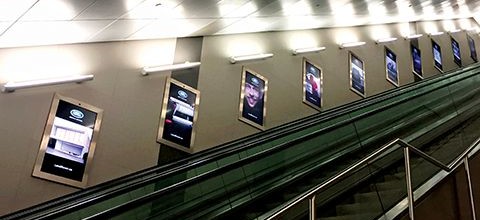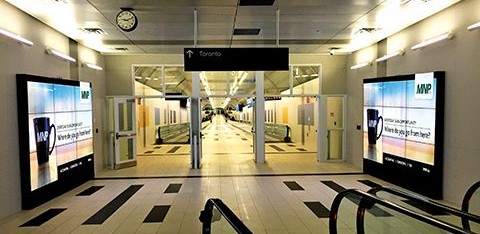A path of screens
The tunnel opened on July 30, 2015, later than scheduled.
“There were delays, but some major advertisers like BMO and Land Rover stuck with us,” says Black.
Shortly after the opening and the digital signage network launch, the mobile app—dubbed ‘Billy’—was made available for Google Android, Apple iOS and BlackBerry devices. Travellers were encouraged to download the app through Bank of Montreal’s (BMO’s) sponsorship of free Wi-Fi service throughout the airport.
Today, as passengers approach the mainland terminal, they first see a 4.9 x 2.4-m (16 x 8-ft) indoor LED-based video wall facing out the windows of the main façade. Once they are indoors, they encounter a 3.7 x 2-m (12 x 6.75-ft) video wall, comprising nine LCDs, primarily dedicated to listing arrivals and departures and secondarily displaying advertising. A 2.4 x 0.7-m (8 x 2.2-ft) double-sided ‘media plinth’ and a 3.1 x 2-m (10.3 x 6.8-ft) nine-LCD video wall help delineate an ‘experiential’ marketing zone, with space to display product samples, kiosks or other collateral. Finally, as travellers arrive at the elevator bank, they see a 7.3 x 2-m (24 x 6.75-ft) 18-LCD video corner wall, which offers multiple templates and channel configurations for ad content. And in the lower level of the mainland terminal, a 2.4 x 2-m (8 x 6.75-ft) six-LCD greets arriving passengers at the elevator bank.

Portrait-mode ‘digital posters’ have been installed alongside the escalators that bring passengers to and from the island-side atrium.
Along the tunnel itself, four ceiling-mounted, double-sided ‘digital skyline’ units support a total of eight 9 x 1-m (29.5 x 3.3-ft) LED screens. For advertisers, these also offer potential integration with static vinyl wraps.
At the lower level of the island-side terminal, two more 3.7 x 2-m (12 x 6.75-ft), nine-LCD video walls greet passengers as they approach the escalators. And as they ascend the escalators, they pass a series of 20 portrait-mode 1.2-m (47-in.) LCD ‘digital posters,’ including 12 on the lower portion and eight on the upper.
Finally, within the island terminal’s ground-level lobby and atrium stand three 2.4 x 2-m (8 x 6.8-ft) MicroTile touch-screen video walls.
“Now is the time for fine tuning,” says Black. “We’ll be adding more screens in the next six months for stronger, long-term branding positions.”
In the meantime, Gridcast continues to monitor and manage the digital signage hardware. And Intel’s Audience Impression Metric (AIM) Suite is being used to measure the network’s performance in terms of reaching travellers, while beacon technology is helping trace how people use the facility.
“The airport has been embraced by business travellers because it offers a convenient, efficient and friendly approach,” says PortsToronto’s Wilson. “The digital experience will add more value and drive engagement by offering relevant information, tools and services. And it will help us better understand our travellers.”
With files from Black and Dot2Dot Communications. For more information, visit www.black-co.com and www.dot2dotcommunications.com.






